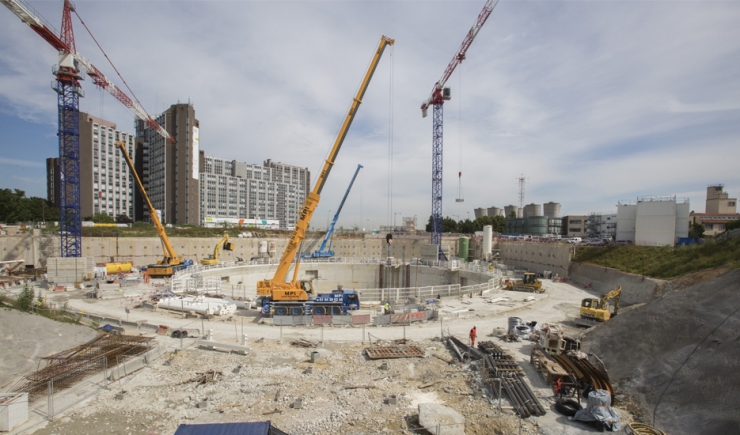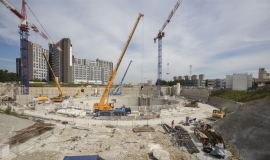The Paris Urbanism Agency (Apur), the public establishment Société du Grand Paris (SGP) and the Ile-de-France Regional Prefecture (DRIEA), present here their most recent publication on the changes taking place in station neighbourhoods of the Grand Paris Express. The construction of housing, territorial rebalancing, social diversity, commitment to environmental issues, accessibility and innovation have all been analysed. This progress report focuses on the 35 stations which will be in service by 2025 and shows an ongoing dynamic at all levels that needs to be reinforced in order to ensure that the future station neighbourhoods be exemplary.

84,000 housing units, 2.5 million m² of office space, and over 2.1 million m² of facilities and other businesses are already programmed in the 35 neighbourhoods located around the Grand Paris Express stations which will be running by 2025. This amounts to a total of over 14 million m² (9.9 million of which remain to be built) divided among 186 urban projects and occupying 28% of the surface area of these neighbourhoods that will have been built within a period of 10 years.
The document “Transformations in the Grand Paris Express station neighbourhoods” provides an update on this unprecedented urban project seen from the angle of 5 major challenges:
- the speeding up of housing construction, functional diversity and territorial rebalancing;
- social diversity and the reduction of inequalities;
- environmental commitment and innovation at the service of a carbon neutral city;
- accessibility and the enhancement of public spaces;
- new ways of operating, diversification of uses and tools.
The following key players also participate actively in the context of the “Vitality of station neighbourhoods” committee initiated by the Ile-de-France Regional Prefect at the end of 2018: Apur, DRIEA, EPF Ile-de-France and the public establishments Grand Paris Aménagement and Société du Grand Paris.
The resulting information
The analysis of each neighbourhood reveals a general trend of improvement in their functional and social diversity. Projects underway include 50% housing and 50% business premises while the current surface area given to housing is dominant (over 60% of existing constructed surface areas are devoted to housing). The analysis of each neighbourhood also highlights the permanent nature of the East-West imbalance in that concerning development projects, despite the enormously improved access to and from the East of the metropolis which offers numerous opportunities for becoming involved in an exceptional urban development dynamic.
The improved access to areas of employment and existing facilities is considerable. This new access will contribute to reducing social inequalities, and notably benefit households in the social housing stock. On average, station neighbourhoods have 30% of social housing and 50% in 6 neighbourhoods. Another example of the changes to come once the Grand Paris network services are operational is that the number of jobs within a 45 minute travel time will be multiplied by 10 for people living in the neighbourhood of Clichy-Montfermeil. Finally a great number of metropolitan facilities and particularly cultural, university and health facilities (Villa Médicis, Institut Gustave-Roussy, Cité Descartes, etc.) will be reachable by a service similar to the Parisian métro, that will render a wide range of destinations accessible within 30 minutes.
One can also note the acceleration of the construction of housing and a diversity of typologies which will open up residential options that are very limited today (social housing produced in the last 3 years amounts to 35% of social housing loans -PLS-, compared with 9% in the previously existing housing stock; new social housing built is 64% made up of small 1 or 2 room housing units compared with 10% in the previously existing stock). This dynamic, which varies from one neighbourhood to the next, should nevertheless be consolidated and intensified.
Finally the study stresses the need to speed up the process of honouring commitments to a zéro carbon city and the environmental ambition, even though future projects adhere more strongly to them than those already carried out.
Areas reserved for public space remain minimal both in quantity and quality. The study emphasises the importance of reducing car parking spaces, embellishing public space, reserving space for eco-friendly transport options, creating numerous crossings and thinking about a suitable programme that provides animation on ground floor premises. Programmes addressing diversity and innovation remain few and far between.
Report : revitalise the dynamic underway
This progress report although non-exhaustive reveals the spacial revolution of territory served by the Grand Paris Express network.
It warns all key players of the necessity to persevere in the efforts underway to make the Grand Paris Express station neighbourhoods exemplary because they are the future showcase and gateway to Grand Paris. It also advocates particular commitment to everything that can develop the East of the metropolis.
In 2020, Apur will continue to analyse these changes by documenting the situation in the 33 neighbourhoods linked to stations that will be in service after 2025.
This work will go into greater depth and be enhanced in the months to come, particularly by qualitative studies carried out in many neighbourhoods in partnership with professionals and students of Paris Dauphine and UPEM, in the context of master degree courses in urban politics.
This publication is included in the work of the Observatory of Grand Paris Express Station Neighbourhoods which was put in place in 2014 and managed by the Paris Urbanism Agency (Apur), with the Societé du Grand Paris (SGP) and the Ile-de-France Regional and Interdepartmental Department of Public Facilities and Development (DRIEA). The Observatory is regularly boosted by exchanges between the Agency’s partners and more particularly Grand Paris Aménagement and the engineering school EPF Ile-de-France.
Access the study
A few slides summarising the study are accessible here
Press contacts :
Apur : Quentin Treton : mail – 01 83 97 63 59
Société du Grand Paris : Jérémy Huppenoire - mail - 06 34 47 16 18 et Guy-Arnaud Behiri - mail - 06 98 82 79 40
DRIEA : Stéphanie Carvalheiro – mail – 01 40 61 82 24

